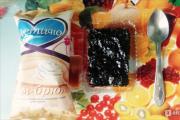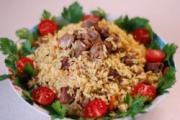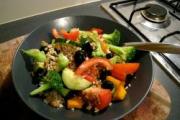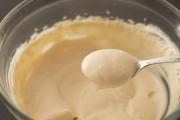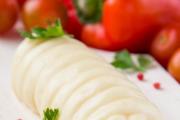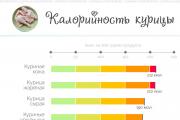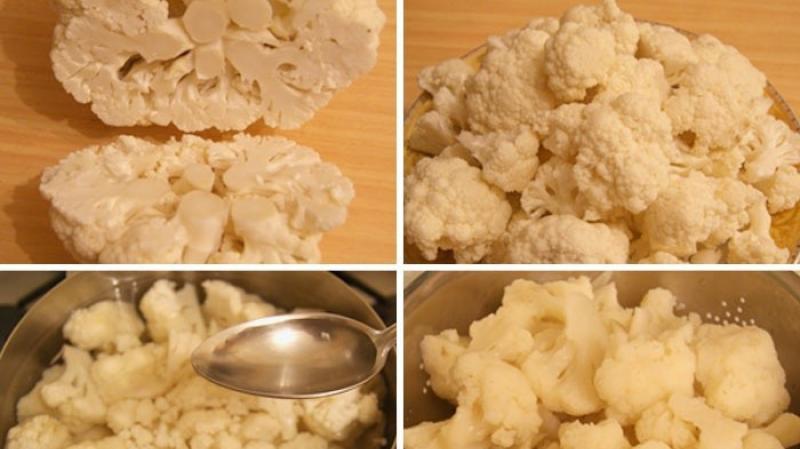How to choose hard cheese. How to choose cheese and what is important to know when buying? The most salty - "Parmesan"
High quality and delicious cheese- is no longer an ordinary phenomenon, but rather an exception to the rule. The conditions of the food embargo were a real challenge for cheese lovers, as many of their favorite varieties of this product disappeared from the shelves. How to find a “decent” cheese - by trial and error, or is there another way? Understanding.
What kind of cheese is
Each country has its own classification of cheeses, which depends on the principle underlying it. There is no single classification, because one cheese can fall into several categories at once. Cheese can be classified by maturity, production technology, composition, type of milk, but the most used and convenient is the classification by hardness. According to this division, cheeses are hard, semi-hard and soft. In turn, these three large groups are divided into smaller ones, among which are curd and pickled cheeses, cheeses with mold and additives, combined and cheeses from different types of milk (cow, goat, buffalo and others). Hard varieties include Russian, Dutch, Gouda, Cheddar, Radamer, Edamer, Parmesan, Emmental, soft ones - Roquefort, Camembert, Mozzarella, Feta.
Each type of cheese has its own unique characteristics that should be considered when choosing a product in a store, but there are general recommendations for all types.
Cheese composition: what should be
Good cheese should consist of only a few components: milk, table salt (sodium chloride or sodium chloride), rennet (its presence is not necessary for some cheeses) and leaven (lactobacilli). The content of calcium chloride, extracts of annatto and carotenoids, fungi (in cheeses with noble mold) and spices is considered normal. This concludes the list of acceptable ingredients that can be contained in a quality cheese.
Ingredients to avoid
Be sure to read the label. Remember, first and foremost, that a “cheese product” is not cheese! Side by side with cheeses, this product attracts attention with a lower price, but it is not a cheese. Not all manufacturers are conscientious and may not put such a mark on their product. Study the composition - the presence of vegetable fats and proteins indicates that you are holding a cheese product.
Now in the production of cheeses, nitrates are used as preservatives - potassium and sodium nitrate. In the finished product, these nitrates practically do not remain, since they are processed into other substances by microorganisms present in the cheese, but why choose a not completely natural product, to which extra preservatives were added? Often, you can also find phosphates (salts of phosphoric acid) in cheese, which are added as acidity regulators and melters. These substances in small doses do not carry any harm, as well as benefit, but in large quantities they can lead to a violation of calcium metabolism in our body. It is better to avoid cheese with such components, because we already consume more phosphorus with other products than necessary.

We evaluate the appearance and smell
Examine the cheese from all sides. Packaging and cheese crust must be free of cracks, as they favor the formation of mold. Uneven or whitish color of the cheese may indicate its immaturity. The eye pattern also matters. Too small is a ripening defect, uneven, which means that low-quality milk was used for the production of cheese. An excessive number of eyes indicates the development of bacteria inside the product.
Hard and semi-hard cheese varieties should not have a wet surface, but it should not be too dry either. Soft cheeses should spring back when pressed. A small amount of whey may appear on a fresh cut. This is considered normal and indicates the freshness of the product. If you find a wet and sticky texture under the packaging, it means that this cheese is already stale and, possibly, even spoiled.
If possible, you should definitely smell the cheese. The ammonia and mushroom odor in most varieties is a sign of decay. This aroma is permissible only for certain types of cheese, for example, for Camembert Lefkadia. The absence of any aroma also characterizes the cheese not for the better.
Cheese packaging
It is better to buy cheese in factory vacuum packaging - this is how it is guaranteed that the product will remain fresh for a long time. The manufacturer and its address, date and time of packaging, expiration date, composition and storage conditions must be indicated. Many shops offer their own sliced and packaged cheeses. It is better not to take such products, since there is a high probability of reproduction under the packaging of pathogens. If you bought such cheese, then make sure that there are no stains and discharge on the surface of the product, and that the edges do not tear or stick.

An important criterion is the price
Cheese is one of those foods, which is better the more expensive it is. A kilogram of quality cheese should not cost less than 700 rubles. Why? Just for 1 kg of cheese you need 10 liters of milk, which is about 600 rubles, and in fact cheese requires other costs of the manufacturer. It turns out that the first criterion when choosing a cheese should be its cost.
How to store cheese properly
Cheese is a living product, meaning it continues to ripen. Improper storage can speed up this process. Cheese should not be stored next to strong-smelling foods - it will absorb this smell, as it is absorbent. It is best to place the cheese in a glass or enamel bowl. Put a couple of sugar cubes there - it will absorb excess moisture. Also cheese can be stored in plastic bag or cling film.

Cheese - milk product or a dairy compound product made from milk, dairy products and milk processing by-products using special starter cultures. A cheese product differs from cheese in that it is milk-containing, i.e. part of the milk fat in it is replaced by non-dairy components.
Cheese is a highly nutritious product. It contains 15 to 25% protein, 20 to 30% fat. Cheese proteins are associated with calcium, which is why they are absorbed much better than from plant foods. It is rich not only in calcium, but also in phosphorus, salts of magnesium, potassium, sodium, trace elements that the body needs for metabolic processes, for hematopoiesis, the activity of hormones, enzymes. There are more vitamins in cheese than in milk.
What to look for when buying cheese?
Quality cheese and fresh cheese- not the same thing. A high-quality product meets the requirements of regulatory documents, but if the cheese has “served” its four-month ripening period and only then hit the counter, is it fresh? If young cheese goes on sale the next day after production, will it be of good quality? Practically philosophical questions that even experts will not answer. Of course, if a black and green fluff flaunts on the head of the cheese, then don't go to the fortuneteller - it is spoiled by mold.
However, cheeses also have other treacherous external signs:
- The cheese dough should be uniform in color from pale yellow to yellow, but if we see white spots on the cut, this is a bad sign.
- Narrow cracks-cracks instead of smooth eyes signal increased acidity.
- Uneven texture of cheese on the cut, "blind spots" free from eyes, where they should be (for example, in Russian cheese), also give out an unscrupulous manufacturer.
How to store cheese after purchase?
Many of us habitually store cheese in the refrigerator, wrapped in its "native" cellophane packaging. However, this is not a good idea.

Of course, nothing fatal will happen to a piece of cheese, but the moisture evaporating from it will condense on the film and can provoke the appearance of mold.
Wrapping the cheese in parchment is a great alternative. The crust may dry out a little in it, but this is just the result of moisture evaporation. But the risk of infecting the product with a fungus becomes much lower.
4 popular cheese myths
Our choice of cheese is often hindered by misconceptions about this product. Let's try to understand the most famous cheese myths.

Myth number 1. Cheese is the least healthy of all dairy products.
This is absolutely not true, because cheese is a concentrate of protein, calcium, microelements, and milk itself is primarily valuable as a product of protein nutrition. To satisfy a person's daily need for milk protein, just a small piece of cheese is enough.
In the process of ripening the cheese mass, protein is decomposed into amino acids, including essential ones, which are not synthesized in the body by themselves and get there only with food. Cheese does a great job of synthesizing them, while swallowing other dairy products simply allows the milk protein to fall into the esophagus, and it still needs to be digested.
Myth number 2. Homemade cheese tastes better and healthier than what is sold in stores.
Whichever “homemade” cheese is meant, the product of the efforts of a housewife who cooked her own cheese in the kitchen in a saucepan made from milk purchased from the market, or the handiwork of a farmer from a European village, the key point is the quality of milk.
The taste qualities of homemade cheeses are quite diverse, and it is impossible to judge them, but it is very possible to pick up harmful microflora if the milk is not pasteurized.
Myth number 3. Unscrupulous manufacturers use vegetable and palm oil instead of milk fat in the production of cheese, and also color the cheese with various dyes.
The current legislation allows replacing part of the milk fat with a substitute. The vegetable fat compositions used in this case are selected so that their characteristics are close to milk fat. For example, there is a tale that if moisture appears on a cut of cheese, it means that the manufacturer used vegetable oil. This is another misconception. Milk fat and its substitutes have the same melting point, and both vegetable fat and milk fat will be melted at a temperature of 30 degrees.
As for the dyes, they are allowed even by our national standard. Naturally, only natural ones, such as beta-carotene. They are used to give the cheese a more intense color, since winter milk gives the cheese a pale color, and customers want to see the product in a standard and familiar yellow color.
Myth number 4. It is safer to buy cheese packaged and cut on the sales floor.
The manufacturer is not legally responsible for the cheese packaged in the trade. Many things affect the quality and shelf life of cheese packaged in a commercial enterprise, including a cutting knife and board in a store, as well as packaging film.
When packing, it is inconvenient to wrap the cheese in the inner side of the packing film from the reel, if the packer is not left-handed, therefore, the cheese is often wrapped by placing it on the outer side of this film. And where the reel with the film lay before packing is a mystery covered in darkness. Therefore, cheeses that are packaged in production are safer. Although they are significantly more expensive.
Some more cheese facts
Cheese was well known long before our era. Homer tells in the Odyssey how travelers, having got into a cave, found a lot of cheeses in baskets. And about the Cyclops Polyphemus writes:
Milk goats and sheep, as is customary for everyone,
He took half of the white milk, instantly fermented,
I immediately squeezed it out and put it in tightly woven baskets ...

The process of curdling milk and making cheese was described by Aristotle in the 4th century BC. Greek cheese from the island of Demos was especially famous in ancient times - it was exported even to Rome. Later, the Romans developed their own varieties of cheese - for example, "moon cheese". It was so tasty that the Roman, describing the lady of the heart, compared her with the taste of "moon cheese". In England, the first recorded cheese recipe was found in a 1390 cookbook owned by King Richard P.
French cheesemaker Andre Simon's book, which he wrote for 17 years, mentions 839 types of cheese.
It is interesting that almost all cheeses have geographical names: Swiss, Dutch, Kostroma, Uglich, Russian, Latvian, Yaroslavl and others. These names are associated with the areas where these cheeses were invented and developed.
Other names of cheeses are associated with the method of production or with the composition of additional raw materials, in other cases they are the names of national cheeses (for example, suluguni, chanakh, porridge, kachkaval and others, common in the Caucasus and Moldova).
Parmesan is named after the Italian city of Parma. It is stored for 1-2 years in a cool, well-ventilated warehouse. The surface of the cheese is rubbed with vegetable oil from time to time. It has a pleasant pungent aroma and salty taste. Parmesan is not used as an independent dish, but for dressing or as a side dish to the famous Italian spaghetti.
The birthplace of Camembert cheese is Normandy. More than 200 years ago, this variety was invented by the Frenchwoman Maria Arel. There is an assumption that Maria Arel named her cheese in honor of the cheerful corporal Camembert, the hero of a popular children's fairy tale.
The organizer of industrial cheese making in Russia was Nikolai Vasilyevich Vereshchagin, the elder brother of the Russian artist V.V. Vereshchagin. On his initiative, in 1866, the first artel cheese dairy was opened in the village of Otrokovichi, Tver province. Following her, artel cheese-making factories arose in other northern provinces. In 1871, N.V. Vereshchagin created the first Russian school of dairy farming in the village of Edimonovo, Tver province.
How to choose cheese and which cheese is the best- French, Italian, or maybe our Russian? What are the tips on the label about the quality of the cheese? Which cheese is right for vegetarians?
Love for cheese goes beyond all boundaries: at the last on World Cheese Awards tried already 2629 types of cheese - almost more than the number of languages in the world (cheese master class from a French chef Guillaume Joly - "How to develop taste without opening your eyes").
Like languages, cheeses are usually divided into families. According to the method of production, they are
- rennet(milk curdles under the influence of rennet),
- fermented milk(lactic acid sourdough is used)
- and fused.
Usually cheese is made from cow, sheep and goat milk or mixtures thereof. For example, an Italian variety Testun al barolo made from cow and sheep. In exotic countries, you can find cheeses made from buffalo, horse or camel milk. Most of all hard and semi-hard cheeses made from cow's milk are in our stores: "Russian", "Kostroma", "Dutch", "Swiss", "Poshekhonsky", "Uglich", "Edam", "Gouda", Oltermanni, Emmental, Maasdam, Radamer.
Hard ripen from 2 months to several years, soft - 2-6 weeks. The older the cheese, the more expensive it is and the more "smelly" it is.
HOW TO CHOOSE CHEESE: ICONS
The quality of the cheeses is protected by origin control. In English-speaking countries, this is a mark PDO or PGI... In France - AOC, in Italy, Spain - Doc, DOP... The badge guarantees that the cheese is produced in a strictly defined area according to strictly defined rules. The quality of our cheeses is, in theory, guaranteed by the inscription "Complies with the technical regulations for milk and dairy products No. 88-FZ" .
CHEESE CRUD
Hard cheeses should be bought with a crust, which should be flat, without white spots or cracks. An overcooked piece of cheese is usually darker and drier near the crust. The crust should not be "sweaty" (produce fat) and lag behind the cheese. Soft and young cheeses do not have a crust, so here, when choosing, you need to focus on the smell and appearance. No cheese can smell like yeast, rot, bitterness, lactic acid. And none can taste like detergents, chemicals, greasy, sour. The edges of the cheese should not be crumbly or cracked, except in rare, expensive, long-aged varieties. These are rare in our stores.
CHEESE COLORING
Summer cheeses are more yellow than winter, because of carotene, which is abundant in fresh grass. But the color can be artificial: the cheeses are painted with beta-carotene, saffron or annatto (extracted from the seeds of the tropical plant Bixa orellana). The more yellow it is, the more attractive it seems to the buyer. And this does not affect the taste in any way. This cheese should not be too bright, striped or blotchy. If the cheese is unevenly colored, it means that it is not ripe - this is a violation of technology. On the other hand, there is nothing wrong with "pale" cheese - it is simply not dyed.
EYES AND TRACKS
Hard and semi-hard varieties should have holes ("eyes" in cheesemaker's jargon). An exception - "Cheddar" and "Parmesan"... If the pattern is uneven, with large eyes in the middle and small ones at the rind, then the cheese is made from low quality milk. Please note that for imported ones, the diameter of the eye should be at least 5 mm, and according to the domestic GOST, small eyes of an irregular and slit shape are permissible. When the eyes are connected in tracks, this is also a sign of poor quality.
LOCATION
Cheese continues to ripen and breathe both on the counter and in your refrigerator. They easily give off their own smell and absorb strangers. Therefore, if you put cheese next to meat or other food with a strong smell, the cheese will change the smell and taste. It is best to keep it in the refrigerator next to dairy products or uncut vegetables. Cheese in the store should not lie close to sausage, meat or fish.
MORE THAN MEAT
Cheese is almost no different from meat. In 100 g of cheese, as in meat, up to 60% fat, and even more protein (up to 33 g) than in meat and fish, therefore it gives a stable feeling of satiety. It also contains a lot of saturated fat and salt. 100 g of cheese can hold up to 100 mg of cholesterol. If you want to lose weight, avoid processed cheeses and long ripening cheeses - they contain up to 400 kcal per 100 g. Less fatty - young and pickled cheeses (mozzarella, feta, feta cheese, suluguni, Ossetian, Adyghe)... Unsalted species are ideal for the dieter. The most fat (63.94%) and the least protein (29.9%) are found in creamy (cream-based) varieties. Least of all - in fermented milk (fat 12.66%, protein 76.90%). By the way, European milk contains more fat than domestic milk, so Swiss cheese made in Russia is less fatty than "native" one.
WHAT CHEESE ARE SUITABLE FOR VEGETARIANS?
Most cheeses are fermented using rennet from the stomachs of calves. For lacto-vegetarians, cheese based on a non-animal enzyme is suitable. Packaging tips: "Microbiological rennet", "mesophilic and thermophilic lactic acid organisms", "enzymes of microbial origin"... Although cheeses based on animal enzymes are always more expensive than "laboratory" ones, the taste of the difference between Italian regular and vegetarian mozzarella is almost imperceptible.
There are more than 500 types and 2000 varieties of cheese in the world. But, despite the diversity, the list of raw materials for the manufacture of this product is limited.
Despite the huge number of variations, cheese is a simple product in its composition.
Cheese quality requirements
The main component is milk, and pasteurized milk, since it is forbidden to produce dairy products from raw milk in Russia. In addition to cow, goat, sheep, and buffalo are used.
Naturally, the organoleptic properties of cheese are influenced by the feed that animals eat and the climate, even with the same recipes, products with different tastes are obtained.
In the production of cheeses of mass demand, Russian producers rely on GOST standards. So, GOST 32260-2013 is the main guideline for the creation of semi-hard cheeses, such as "Russian", "Gollandsky", "Kostromskoy".
As for small farms, they make original cheeses, and not according to GOSTs, but according to TU and own recipes... But it is almost impossible to understand whether farmers pasteurize milk for cheese.
In addition to milk, the composition contains salt, bacterial starter culture and rennet (on the package it is listed as “an enzyme preparation of animal origin”). It is produced in the stomach of calves or adult animals - bulls, pigs, and is used for curdling milk. This component is also obtained from genetically modified microorganisms that produce enzymes, which are almost identical in composition and properties to calf. Animal enzymes are more expensive.
A separate variety is fermented milk cheeses, similar to cottage cheese. They do not mature; lactic acid bacteria are used for their preparation, usually without the use of milk-clotting enzymes.
There should be no vegetable fats in the composition, otherwise it is already a cheese product - and vegetable substitutes for milk fat are just allowed in it.
Potassium chloride can be found in the list of ingredients - it is used as a sealant, and it does not cause any doubts among technologists.
What can not be said about potassium nitrate (E252), sodium nitrate (E251) and lysozyme (E1105). These are preservatives, of course, permitted by GOST. But you can usually find them in inexpensive cheese. They protect it from damage, but, according to experts, a product made from high-quality raw materials does not need such additives.
The use of dyes is allowed, but GOST permits only natural beta-carotene or annatto. However, quality cheese it may well do without tinting.
Cheese is a derivative of mother's milk. That is, a product to which all people have an innate genetic instinct. Dairy proteins, which means animals, are a necessary building material for our body, because they contain a complete set of amino acids.
It is difficult to talk about the big difference between hard and soft cheeses. The benefits of them are about the same. But, if a person is on a diet, then hard cheese is recommended. It has a richer taste. Therefore, it is easier for them to eat or satisfy their passion for cheese. And passion can be strong. This food dependence is explained by the optimal combination of fat and salt in its composition. Therefore, it is delicious.
There are also contraindications.
- Diseases of the gastrointestinal tract.
- Overweight people.
- Limit in case of cardiovascular diseases, for example, atherosclerosis.
The harm to cheese is due to animal fats and its calorie content. This is a heavy dish. That is, you can afford a cheese sandwich every morning, but the benefits of this sandwich will depend on the thickness of the cheese, the thinner the better.
The quality of Russian cheese
The most popular domestic cheese is inexpensive and tasty Russian cheese. But not every Russian has the right to be called that.
How to check the quality of Russian cheese?
- It should have an openwork pattern of irregular eyes, they should be small in size - no more than 2 mm, be spaced from each other at a distance of 2-3 mm and run along the entire cheese head. If the holes are large or stuck together, the cheese can sour.
- The crust is thin and even. And the consistency is elastic, but GOST also allows slightly dense.
- The color should be from white to light yellow, always uniform. If the color is not uniform, it means that it is not ripe. If it is bright yellow, produced in winter, most likely there are dyes there.
- The composition should not contain preservatives
- Among the cheeses made in accordance with GOST, choose a premium product.
The inscription 50% does not mean at all that exactly half of the product consists of fat. The figure falls on the share of dry matter, that is, cheese without water. Therefore, 100 g contains only 29 g of fat. Nevertheless, according to the official classification, cheese with a fat content of 45% to 59.9% is already fat.
During maturation, the semi-finished cheese mass turns into real cheese. Under the influence of enzymes, protein breaks down into simple compounds - primarily into useful amino acids. The cheese becomes darker, a characteristic pattern appears, a crust and a sour-creamy taste beloved by many (according to technology, this is cheese with high acidity).

If the product is not allowed to linger or the manufacturing process has been accelerated, it will taste bitter, crumble or taste "rubbery", and the eyes will be sparse and very small.
Depending on the quality, GOST divides semi-hard cheeses into premium and first grade. This means that the appearance, taste, smell, consistency, color, packaging and labeling scored the maximum number of points on a special scale. The grade in production is determined, controlled by the quality department. If some cheese does not gain the highest score, then the first grade is assigned to it.
The manufacturer himself decides whether to indicate the grade on the package or not. If you buy a product in accordance with GOST, then choose the one where the variety is indicated.
The quality of Kostroma cheese
Kostromskoy is the closest relative of the Dutch Gouda cheese. Nevertheless, it is considered ours, family, because it appeared in Russia. Now it is included in the list of the most popular domestic cheeses.
This is a semi-hard cheese, 45% fat.
High-quality "Kostroma" should contain:
- milk;
- bacterial starter culture;
- milk-clotting enzyme preparation of animal origin;
- calcium chloride sealant;
- salt;
- natural dyes - beta-carotene, annatto.
Pay attention to the color, it should be from white to light yellow. Uneven color, "marbling", gives production errors.
Such a product ripens quickly, only 45 days. In a month and a half of ripening, chemical composition, which is characteristic of this particular species. Here every detail is important - and the size of the curd, and the duration of processing, time, heating procedure. Even a clear amount of overturns during ripening. "Kostroma" is turned over 2-3 times.
Only by observing all the rules in accordance with GOST, the cheese will turn out to be correct, and any violations can spoil it.
But, unfortunately, we will not be able to determine whether there were any violations, standing at the store counter.
How to determine the quality of Kostroma cheese?
- On the surface, there must be oval or round eyes. Holes in such a product are formed when the starter culture microorganisms "breathe", emitting carbon dioxide and forming voids in the cheese bed. Therefore, the ideal eyes should be of the correct shape. But in practice, this is not always possible, due to poor quality raw materials or unsuccessful starter culture.
- If there are few holes, the cheese has not ripened correctly, the taste will be dim. Or it contains a lot of vegetable fats.
- It is bad if instead of oval eyes on the surface there are cracks. The taste will be sour. If the eyes are too large, then the maturation process may have been accelerated.
- It should have a firm and elastic consistency, not break on bending. Good cheese does not "spread", losing its shape, and does not crack.
- Cheese crust - smooth, thin, without a thick subcrustal layer. If the protective layer is damaged, it means that the damaged areas were cut off in the store.
If you buy slices, it is better to choose the one that is not made in a store, but in production, in an industrial way. Only then will it be absolutely safe, and you will be sure that you are buying exactly Kostromskaya.
Cheese absorbs odors well. If you choose a product by weight, be sure to look at the location of the counter. There should not be any strong-smelling products nearby.
Dutch cheese quality
By and large, many semi-hard cheeses can be called Dutch. Indeed, the Dutch group includes, for example, "Kostomskoy", "Poshekhonsky", "Uglichsky". All of them are similar in technology - semi-solid rennet, with a low temperature of the second heating.
And even slightly different in taste. But only one is called "Dutch".
"Dutch" cheese is amazing - it has a foreign name, but our origin is Russian. Its recipe was developed by our cheesemakers 150 years ago, although this cheese still has a close connection with Holland. He is a descendant of the classic Edamer cheese.
"Holland" is a semi-hard cheese made from cow's milk. GOST for it has existed since Soviet times. The standard is updated periodically, but the list of ingredients is the same:
- milk;
- leaven;
- rennet extract;
- salt;
- dyes.
Such a product can be of different fat content - 45% and 50%. Cheese with a fat content of 45% is produced in the form of a bar, it ripens for at least 60 days. But fatter it has a spherical shape and ripens for at least 75 days.
GOST allows the release of a product for sale at the age of 45 days, if it is highly appreciated in taste, smell, appearance, consistency.
How to determine the quality of Dutch cheese?
- There should always be a drawing: the eyes should be clearly visible on the cut. They can be of completely different shapes - round, oval, angular with uneven edges.
- The crust is smooth, thin.
- The consistency is elastic. If, when slicing, you notice that the cheese is soft and sticks to the knife, then this is a stale or overripe product.
- Shouldn't fall apart. But the state standard allows you to break slightly at a bend. So, if you made a sandwich in the morning, a broken piece of cheese shouldn't spoil your mood.
- Technologists explain - if "Gollandskiy" seems to "cry", that is, when droplets of moisture are visible on the cut, this is good. Cheese "tears" speak of full ripeness and its good, rich taste.
- The most important word should be on the packaging - "cheese". If it is not there (for example, simply "Gollandskiy" - without specification, cheese or cheese product), then, most likely, the manufacturer hesitated to tell customers that there is a cheese product in the package.
The quality of Poshekhonsky cheese
Imported hard and semi-hard cheeses are expensive, of course, not only because of the sanctions, but also because they ripen sometimes for years and in special conditions.
As a result, the product is light (45% fat) and ripens quickly (up to 45 days).
"Peshekhonskiy" is a semi-hard rennet cheese, but it was not included in the GOST for semi-hard cheeses.
Nevertheless, its composition does not differ from other semi-solid and is simple:
- pasteurized cow's milk;
- rennet extract;
- bacterial leaven;
- salt.
Poshekhonsky is very similar to Kostromskaya. The color can be white and light yellow. Taste is moderately cheesy, sourish.
Light spice and bitterness are allowed. If the cheese has a milk smell, but there is no sourness smell, this means that the ripening process has not gone through a full cycle.
At the expiration date, strong bitterness may appear, therefore, on the label, in addition to the packaging date and the expiration date, look for the third digit - the production date.
Better not to guess and ask the seller to cut off a piece of cheese from the head in front of you. This way you can be sure that it has not been re-packaged several times.
The cheese eyes should be round or oval, but evenly distributed over the surface.
If the product is made from low-quality milk, the holes will be small at the edges, and large and torn in the middle, with cracks.
Processed cheese quality
It appeared in the last century, and has changed significantly since then. The composition has become more complex, the price has increased, the range has expanded, but the reputation among nutritionists, on the contrary, has fallen.
But the people's love remained.
Processed cheeses are:
- chunks;
- pasty;
- sweet and special for soup;
- smoked, with fillers, with and without flavorings;
- different fat content;
- pasteurized, sterilized and untreated.
With classical pasteurization (heating up to 83 degrees), harmful microbes are killed, but some of the useful ones remain.
With hard processing (up to +140), everything dies.
You will not see the production method on the label. But the expiration date will help you. Pasteurized is stored no longer than 6 months, sterilized - more than a year.
- In the first place in the list of ingredients should be cheese, or cheese and cottage cheese. For production use: "Russian, Kostroma, Shauda, Emmental. If the raw material is not mature enough, then the taste will be weak, dull. If overripe, loose.
- The composition may contain cream, powdered milk, water, salt. Even the highest quality product contains additives. Processed cheese simply won't work without them.
- Melting salts are emulsifiers that, during the melting process, interact with the protein, converting it from insoluble to soluble.
GOST lists 17 additives with the letter E.
Often used:
- Sodium triphosphate (E 451);
- Sodium pyrophosphate (E 450);
- Sodium orthophosphate (E339).
Technologists are convinced that they should not be feared, they are of natural origin. Phosphates are a natural component, citrates are citric acid salts.
Often found in the composition of preservatives. Gosstandart allows natural ones, for example, sorbic acid (E 200), which is found in cranberries.
Dyes, thickeners, acidity regulators are also allowed.
But what exactly should not be in the composition is vegetable fats, only milk.
The main principle when studying ingredients is that the shorter it is, the better.
Nutritionists, due to the large amount of E in the composition, consider this product to be heavy and allergic. Compared to hard cheeses, processed cheese contains a lot of sodium and is not recommended for those who suffer from hypertension.
Phosphates can "flush" calcium out of bones.
Processed cheese is a universal product. Can replace meat in soup, add flavor to sauce, make hearty light salad or turn a hearty one into a full-fledged second dish. Therefore, it is very different, with mushrooms, herbs, ham.
The main thing is that what is stated on the label is inside. If the name contains the word "ham", then, of course, we expect it to be inside the jar too. You can understand a real ham, or a substitute, by examining the packaging. The ham must be indicated in the composition. And the product should be called "with ham". If it says: owl with ham, then the manufacturer replaced the meat with artificial additives and flavorings.
Real ham will never color, the color should remain the correct light cream shade.
Production without flavorings is impossible. After all, any filler in the process heat treatment loses its taste even without food additives it just won't feel in the cheese. Therefore, as a rule, the composition contains both the fillers themselves and their flavors at the same time.
How to determine the quality of processed cheese?
- Should spread smoothly and be uniform, with a glossy surface. According to GOST, there should be no pattern on the surface. Pictures are not allowed. If they are, most likely this product was stored incorrectly, perhaps it “survived” temperature changes.
- Color from white to intense yellow. If the cheese is bitter or has a soda taste in it, then the proportion of the melting salts has been violated.
- Look at the bottom of the plastic packaging before buying. If you see the letters PS, then it is made of polystyrene. It can release toxins when it interacts with hot or acidic products. Better if you see the letters PP - polypropylene container.
The quality of the sausage cheese
They say about such a product that there is no sausage, and there is not enough cheese. But in stores, the demand for it does not disappear. How to choose the best one?
Sausage cheese belongs to processed cheeses. Substandard cheeses or special cheese mass for melting are often used as a base. Moreover, the manufacturer is not obliged to indicate the varieties.
Ideal composition on the label:
- semi-hard cheese;
- cottage cheese;
- butter;
- powdered milk;
- water;
- melting salts.
The resulting mass is formed into loaves.
A distinctive feature of such a product is not only its shape, but also its aroma. The methods of obtaining it are different.
High-quality smoked on natural sawdust of non-resinous trees, for example, alder or oak. But they can also save money - add smoke flavors. To buy a natural smoked product, see the name.
It should say smoked, not smoked. Look at the shell - paraffin wax or film coating. It is paraffin that allows you to better smoke the cheese and extend the shelf life.
The uneven color also speaks of artificial smoking. A good product has a uniform shade ranging from light beige to brown. The structure is not brittle, not stringy. It is dense and dry.
On the cut, the cheese mass is free of yellow streaks and cracks. Voids and holes indicate microbiological deterioration - it is better not to buy such a product.
If the manufacturer has gone too far with the melting salts. the crust will turn out to be spotty, and the taste will suffer. The surface is not damaged. Paraffin is not sprinkled, the shell is dry.
Sausage cheese or cheese product?
You will find vegetable fats in the cheese product. Indeed, in production processed cheese there should be only milk fats.
In most cases, in appearance or taste, natural sausage cheese is practically indistinguishable from its vegetable clone. But their biological value is different.
Do not forget that it is impossible to make such a product without dyes, emulsifiers - vegetable fats require an improvement in consistency and a pleasant aroma.
Several rules for choosing a product with a high milk fat content.
- Mass fraction of milk fat is more than 50%.
- The shorter the shelf life, the more dairy ingredients it contains and, of course, the more natural it is. Shelf life is not more than 3 months.
- The name "Processed cheese product" means the content of cheese is much less than what is called: "Processed cheese product".
- If cheese is in the first place in the list of ingredients, then it is the most in the product.
- A quality product is neither hard nor too soft, elastic. Its color is uniform, easy to cut, does not break or crumble. The smoky aroma is not harsh.
Conclusion: the quality of the cheese will help us to determine its color, appearance, composition. When buying a product, pay attention to the composition, packaging, expiration date.
There are many tips on how to distinguish high-quality cheese from fake cheese on the Internet. But there is little sense from these tips. There are a lot of types and varieties of cheese, so it is impossible to determine the quality of cheese by how a slice of cheese bends, breaks or behaves when heated. Modern counterfeit - these are not only super-cheap cheeses, but also premium foreign brands with a high price. You can check for the presence of vegetable fats in them only with a special device - a luminoscope. Ordinary buyers can only rely on their knowledge of what the "correct" cheese is, how it differs from the "cheese product". Let's figure it out.
Cheese color and appearance
Too saturated the yellow color of the cheese prepares what is in the composition dye... It is possible that the dye used by the manufacturer is natural and will not harm you. But if you are a principled opponent of such additives - do not buy too "bright" cheese.Uneven color cheese may indicate that the cheese is unripe. If the crust has deposits and cracks, it is possible that the cheese was stored incorrectly or the technical conditions of production were violated. If you notice in the package moisture(does not apply to rossol cheeses), if the cheese is sticky, vegetable fats are guaranteed to be used in its production, and this may not always be indicated on the packaging. Holes in the cheese. If you like cheeses like Mazdam - with large holes and a sweetish taste, pay attention to the size and shape of the cheese eyes. Natural cheese has a regular shape with smooth edges. Large eyes in the middle of the cheese wheel and small ones at the edges are a sign of a fake.
Attention to Packaging!

When choosing cheese on a store shelf, it is best to give preference to
factory packaging, where its exact composition, shelf life and shelf life are spelled out (you can check the ripening time), there is information about the manufacturer. On prepackaged pieces of cheese, which are in the dairy section of the supermarket, the composition, as a rule, is not written. To find out, you will have to contact the store manager and request a product certificate. And the shelf life of the cheese packaged in the store (or even more so at the fair or on the market) is problematic to determine if the packing date is not specified. In addition, there is a possibility that the stale cheese could be additionally processed or washed before packaging the cheese.
What should be on the package?
- Product name (cheese or cheese product)
- The value of the mass fraction of fat in percent, grade (if any),
- Manufacturer's name and location,
- Manufacturer's trademark (if any),
- The value of the net weight or volume of the product,
- Production dates (day, month),
- Composition of the product
Cheese and cheese product - what's the difference?

Real natural cheese is obtained by curdling milk and further processing the resulting curd. Cheese may contain only milk, rennet or its artificial analogs, fermented milk culture, salt, calcium chloride to improve curdling. Cheese contains proteins (15-27%), fats (20-32%, in dry matter - up to 55%), minerals, vitamins A and B. Cheese is far from a dietary product, the energy value of 100 g of cheese is up to 400 kcal ... Cheese is a source of essential amino acids, including the most deficient ones - tryptophan, lysine and methionine. As you know, the most useful for the body are those proteins that are similar in amino acid content to proteins of human tissues and organs. And cheese protein meets these requirements. Moreover, it has the ability to enrich the amino acid composition of proteins in other foods. And also in the cheese is calcium in a well-absorbed form.
Cheese product made using cheese technology, but instead of cream (milk fat), it uses vegetable fat / protein. And vegetable fat in the composition can be more than 50%. In some types of cheese product, milk fat is not used at all - it is completely replaced with vegetable fat. The benefits of a cheese product are determined by the quality of plant materials. After all, vegetable fat can also contain useful substances. But often the cheapest vegetable raw materials are used, and even palm oil is added to the cheese product - a very cheap raw material that is used in order to reduce the cost of production and increase its shelf life.
There is no more than 20% of real milk in a cheese product, and the rest is non-dairy fat and protein. As a rule, manufacturers of such products use cheap coconut or palm oil in their production. It would seem that it's okay, because vegetable oils good for the health. Depends on what. In the case of using palm, rapeseed and coconut oils containing saturated fats, they are even dangerous to the human body. These oils are converted into trans-isomeric or transgenic fats and subsequently cause cardiovascular diseases, cholecystitis, obesity, atherosclerosis, vascular thrombosis, etc.
Technical conditions allow replacing milk fat with vegetable analogues with a percentage of 20, 50 and even 100, but everything must be declared on the label.
